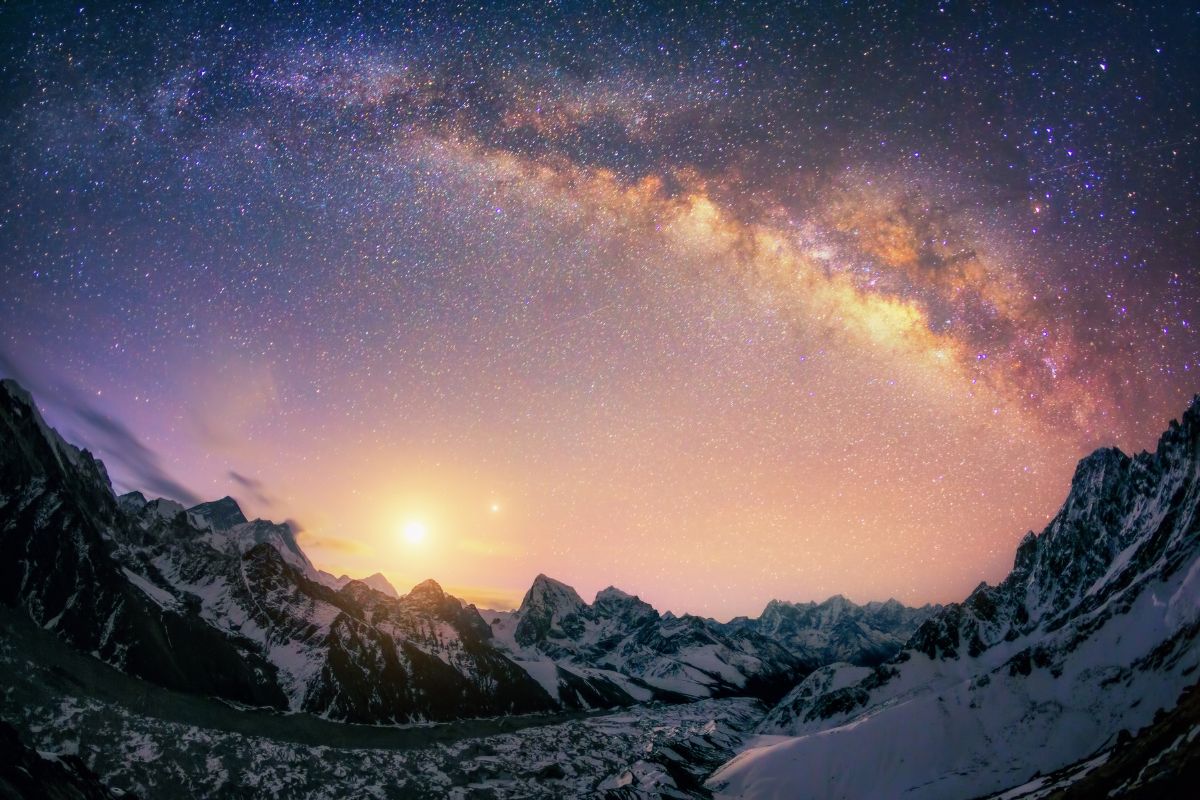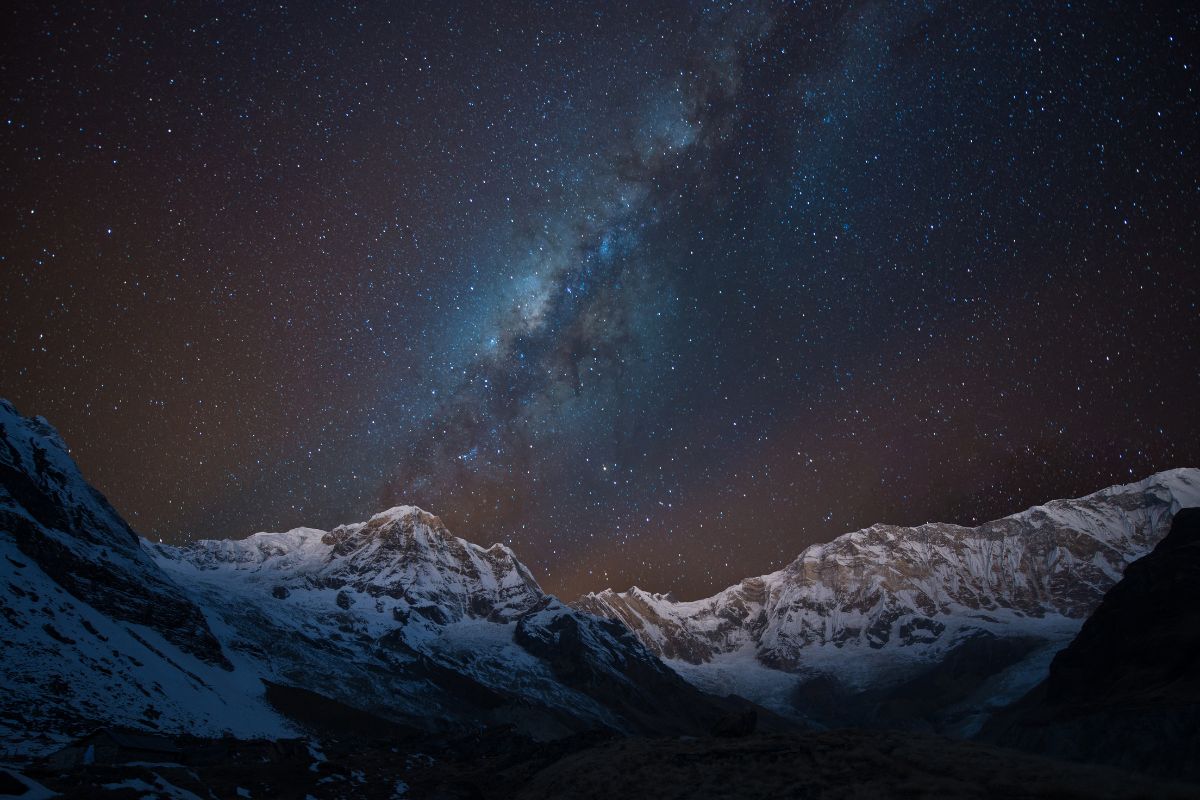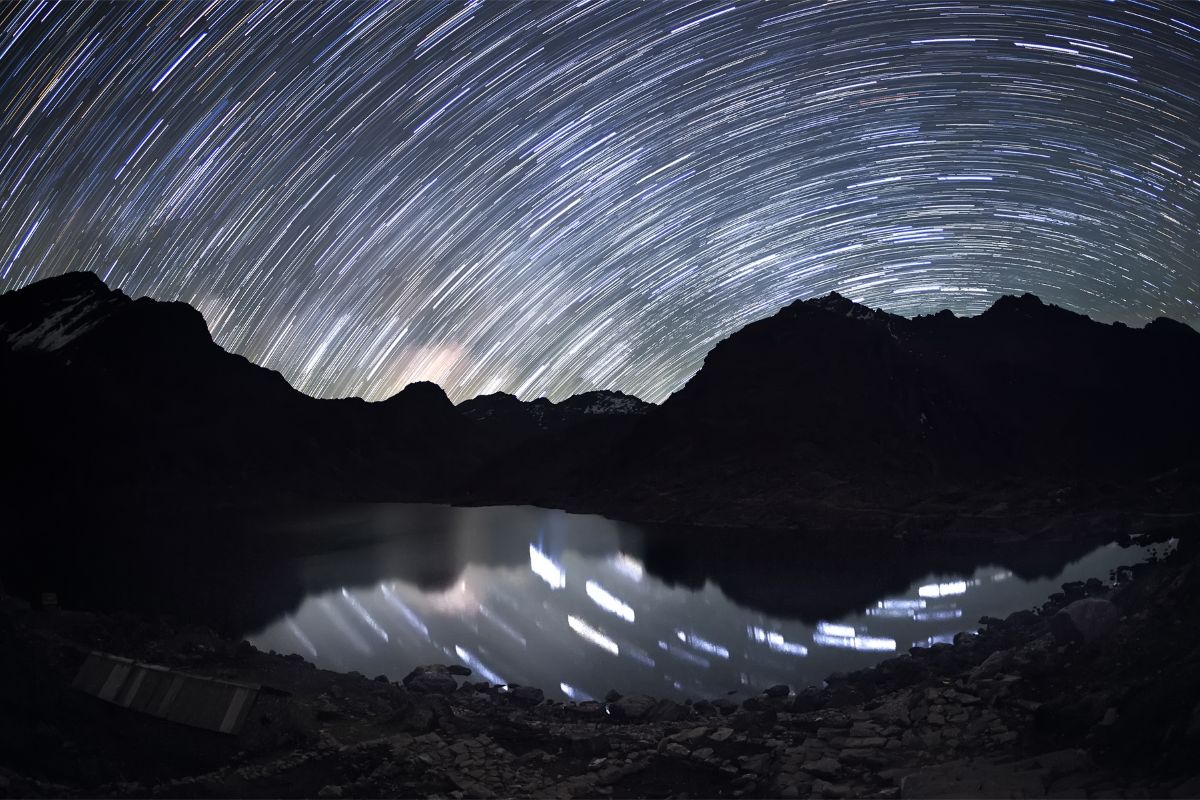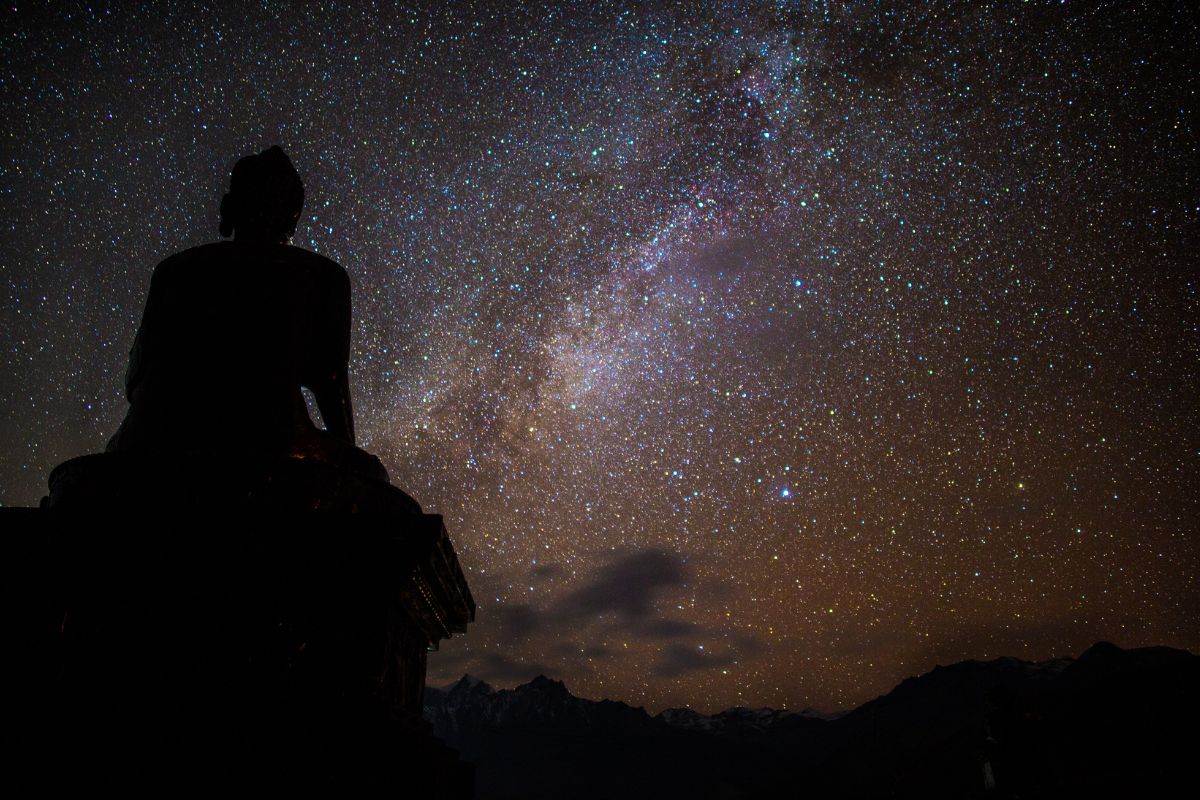
Stargazing in Nepal: Why Nepal Is the Best Stargazing Destination?

Stargazing in Nepal: Why Nepal Is the Best Stargazing Destination?
swotah travel
7021
18, 10 2023
The mysteries of the cosmos have always captivated the human imagination. Gazing up at the night sky dotted with shimmering stars, galaxies, and other celestial wonders, offers an unparalleled experience of serenity and awe. But with growing urbanization and light pollution, such pristine views of the night sky are becoming increasingly rare. That is, unless you find yourself in Nepal.
Nepal, globally recognized for its towering peaks and scenic landscapes, is also emerging as a premium stargazing destination, drawing both astronomy enthusiasts and casual stargazers.
With its diverse topography and pristine environments, it offers stargazers clear, undisturbed views of the skies. The combination of high altitudes, clear skies, and rich cultural narratives about the cosmos makes Nepal a unique stargazing destination.
Here's why Nepal stands out as an exceptional destination for stargazing:

1. An International Recognition
In 2016, the famed National Geographic acknowledged the celestial allure of Nepal by listing Sagarmatha National Park as one of the world's top five stargazing sites. Such recognition is not merely symbolic but an endorsement of Nepal's naturally endowed conditions suitable for astrotourism.
2. Natural Darkness and Low Light Pollution
One of Nepal's most distinctive advantages is its remoteness. Far away from the bustling city lights, many regions in Nepal are untouched by the haze and glow of artificial lights.
In many parts of Nepal, especially in the more remote and rural regions, there's an absence of big cities and industries. This means that the skies remain dark when the sun sets. Natural darkness is a gift for star lovers. In many parts of the world, even if you escape the city lights, there's a lingering glow on the horizon. But in Nepal, once the sun dips behind the mountains, the sky becomes a canvas of deep blacks and twinkling stars. This natural darkness lets the stars shine brighter and allows people to view celestial objects with much more clarity.
Light pollution is the glow that drowns out the stars in the night sky. It's caused by artificial lights from cities, vehicles, and other man-made sources. In Nepal, vast stretches of land are untouched by this man-made glow. Many villages and towns still rely on minimal lighting, and the vast landscapes between settlements mean there’s less scattering of light. This ensures that the skies above remain clear, letting stargazers enjoy a breathtaking view of the Milky Way, distant planets, and meteor showers.

3. Combining Nature with the Night Sky
While stargazing can be a stand-alone attraction, Nepal offers the additional advantage of blending it with other nature-based activities. Tourists interested in observing the night sky might also be enticed by the prospects of trekking, rafting, wildlife watching, birdwatching, and nature photography. This synergy amplifies the overall experience, allowing visitors to immerse in both the terrestrial wonders during the day and the celestial marvels at night.
4. Minimal Sources of Artificial Light
Within Nepal's national parks, the primary sources of artificial light are park offices, army barracks, and a few scattered settlements. But even these sources are far less intense compared to the urban lights in major cities worldwide. This limited illumination ensures that the night sky remains predominantly unspoiled.
5. A Rich Astronomical Heritage
The night sky has profound significance in various cultures. Historically, the view of the heavens inspired awe, led to the birth and growth of astronomy and astrology, and influenced artistic expressions. In many regions around the world, this heritage is being lost due to extensive light pollution. However, in Nepal, this legacy remains intact, providing a bridge between the past and the present.
6. The Threat of Satellite Constellations
The recent trend of launching numerous satellite constellations, like SpaceX's plans to deploy 12,000 satellites, poses a potential threat to night sky observations. These satellites can appear as bright spots moving across the sky, potentially outnumbering visible stars. While some companies have started to address this issue by darkening their satellites, it remains a concern for the global stargazing community. Yet, amidst these challenges, Nepal's dark skies still offer relatively pristine views, further elevating its position as a top stargazing destination.
7. Biodiversity Relies on Darkness
Beyond human observers, the darkness of the night plays a crucial role in the survival of numerous species. From providing cover from predators to influencing reproductive cycles, the darkness is essential. The adverse effects of artificial lighting on biodiversity are only now becoming evident, emphasizing the importance of regions like Nepal, where natural darkness still prevails.

Top 5 stargazing spots in Nepal
While Nepal is dotted with numerous spots perfect for night sky observation, here are five spots that you shouldn't miss:
1. Sagarmatha National Park
Sagarmatha National Park, home to the iconic Mount Everest, is the epitome of pristine nature and untamed wilderness. Its elevation, combined with the remote location like namche, and dingboche, ensures that the skies remain uncontaminated by the artificial lights that plague many parts of the world. This elevation advantage presents a clearer, more detailed view of the celestial bodies. The thin atmosphere at such high altitudes allows for lesser atmospheric distortion, making stars, planets, and other celestial wonders appear more vivid and brighter. The park's expansive landscapes, dotted with glacial rivers and dense forests, provide a vast canvas against which the Milky Way and countless stars paint a breathtaking picture. This surreal setting, devoid of urban disturbances, offers an unparalleled, immersive stargazing experience.
As for the best time to indulge in this celestial treat at Sagarmatha National Park, the winter months (December and January) and post-monsoon months (October and November) stand out. During these periods, the skies are predominantly clear, and the weather conditions are stable, with minimal cloud cover. These factors allow for an uninterrupted gaze into the vastness of the universe. The crispness of the autumn air in the post-monsoon months, in particular, enhances the clarity, making constellations, shooting stars, and even distant galaxies discernible to the naked eye. It's a symphony of the cosmos, and Sagarmatha offers the best seats in the house.
2. Rara Lake
Rara Lake is not just the largest lake in Nepal, but it is also a canvas that captures the beauty of the heavens above. Located in Northwestern Nepal, this secluded oasis offers a tranquil environment that is perfect for stargazers who cherish peace and solitude.
Experiencing tranquility under the stars: The lake's calm waters serve as a natural mirror, reflecting the dazzling sky above. With minimal light pollution, the area surrounding Rara Lake is perfect for observing meteor showers, constellations, and the Milky Way, creating an almost otherworldly experience for its visitors.
3. Annapurna Base Camp
The Annapurna region is known for its breathtaking trekking trails, but once the sun sets, the Annapurna Base Camp becomes a celestial observatory.
Combining treks and starry nights: After a long day of trekking, as you set up camp in the shadow of the Annapurna massif, the heavens unfold in their full glory. The high elevation and clear atmosphere allow for spectacular views of the night sky, making the fatigue of the day's journey completely worth it.
4. Gosaikunda Lake
Gosaikunda, an alpine freshwater lake located in Langtang National Park, is much more than a natural wonder. For many, it's a spiritual sanctuary.
A spiritual experience with the cosmos: Revered as a sacred spot, especially during the Janai Purnima festival, Gosaikunda offers stargazers an experience that is both cosmic and spiritual. Surrounded by snow-capped peaks, as you lay under the vast sky, there's an overwhelming sense of being one with the universe.
5. Upper Mustang
Often referred to as the 'Forbidden Kingdom' due to its restricted access in the past, Upper Mustang is a realm that appears suspended in time. Its barren landscapes, reminiscent of another planet, are as surreal during daylight as they are under starlight.
The dance of stars in the Forbidden Kingdom: Stargazing in Upper Mustang is a journey through time and space. Ancient monasteries, centuries-old caves, and unique rock formations surround you as the night sky puts on a show of shooting stars, bright planets, and distant galaxies.
Preparations for a stargazing trip in Nepal
Nepal, with its lofty Himalayan ranges and unpolluted skies, offers an unparalleled experience of stargazing. Once you've decided on the perfect location in this magnificent country, it's time to prepare adequately to ensure you get the best out of your celestial expedition. Here's a detailed guide:
Equipment Essentials
-
Telescope or Binoculars: One of the primary tools for stargazing is a good quality telescope. It can magnify distant stars, planets, and other celestial bodies, giving you a closer look at the universe's wonders. However, if you're on a budget or need something more portable, a pair of binoculars can also work wonders. Opt for ones designed for astronomical viewing to get the best results.
-
Star Apps and Maps: While the night sky is mesmerizing, it can also be a bit overwhelming for a novice. To help you identify constellations, stars, and planets, there are several stargazing apps available for smartphones and tablets. These apps often use augmented reality, overlaying names and patterns on the sky as seen through your device's camera. Alternatively, a physical star map can be a great resource, especially in areas with limited internet connectivity.
-
Other Equipment: A red flashlight is essential for reading maps or adjusting your equipment without ruining your night vision. Additionally, bring along a notebook or journal to jot down your observations and experiences.
Tips to Maximize the Experience
-
Stay Warm: The Himalayan regions, especially at higher altitudes, can get exceptionally chilly, particularly during the night. It's essential to dress in layers. Start with moisture-wicking base layers to keep sweat away, followed by insulating layers like fleece or down jackets, and finally, a windproof and waterproof outer layer. Don't forget a warm hat, gloves, and a good pair of insulated boots. A thermos filled with a hot beverage can also be a lifesaver.
-
Avoid Full Moon Nights: The brightness of a full moon can wash out the fainter stars, making them difficult to observe. For the best stargazing experience, plan your trip during a new moon or when the moon is in a crescent or gibbous phase. Utilize lunar calendars or apps to track the moon's phases.
-
Be Patient: Stargazing isn't a race. The universe has been around for billions of years, and its beauty unfolds slowly. Your eyes can take up to 20 minutes to fully adapt to the darkness, so give them time. Settle down, relax, and let the stars gradually come into view. The longer you gaze, the more you'
The celestial wonders awaiting you
Ever dreamt of stargazing amidst the mighty Himalayas? Swotah Travel presents an exclusive 5-day stargazing tour in Sagarmatha National Park, home to the world-renowned Mount Everest. Immerse yourself in the splendor of the night sky, all while surrounded by some of the world's most majestic peaks.
What You'll Experience:
-
Starry Nights: With minimal light pollution, observe constellations, shooting stars, and the ethereal glow of the Milky Way like never before.
-
Expert Guidance: Our team of professional astronomers will be on hand with telescopes and knowledge, ensuring you get the most out of your stargazing experience.
-
Daytime Explorations: While nights are for the stars, days are for exploring the breathtaking landscapes and vibrant Sherpa culture of Sagarmatha National Park.
-
Luxury Camping: Enjoy comfortable tents, warm meals, and a bonfire every night as you camp under the open sky.
Why Choose Swotah Travel?
-
Experience: Years of organizing trekking and stargazing tours in the Himalayas.
-
Safety First: Our team prioritizes your safety, with all necessary equipment and a trained crew.
-
Affordable Packages: Competitive pricing without compromising on the quality of experience.
-
Local Insights: Our local guides offer authentic experiences, sharing tales and traditions of the Sherpa community.
Conclusion
Nepal, with its towering peaks and serene lakes, offers stargazing experiences like nowhere else. Whether you're an avid astronomer or someone looking for a tranquil escape, Nepal's night skies beckon you. So, when are you packing your telescope?
NEWSLETTER SIGNUP
Sign up to receive our trip ideas and travel offers!
Get updates and Exclusive Offers up to 20% Discount








